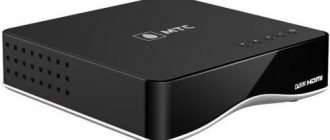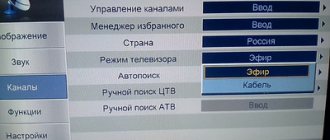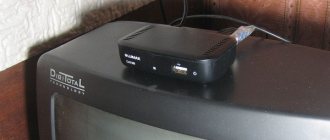It is no longer possible to imagine a single family without a TV. It is needed for watching news, movies, entertainment programs or as a background for everyday activities. But sometimes problems can arise with it. This can bring enormous inconvenience and chaos to the normal course of time. Many people are faced with the fact that a completely new TV does not show anything at all.
In this case, you just need to configure it correctly. And sometimes some channels begin to disappear on an old device. And in general, it’s terrible when the most loved ones disappear. This could be a breakdown or glitch that you can fix at home yourself. If you also have problems with your TV, do not worry, but read the tips on how to fix it.
Methods for receiving digital TV channels
You can catch numbers in several ways:
• Essential;
• Cable;
• Sputnikov.
The signal for terrestrial TV is distributed using terrestrial repeater towers. In order to receive it, you need an antenna. Using this technology, the image is transmitted free of charge. But using this method, the TV often does not pick up the signal well. Because the quality of the picture is affected by where the tower is located, what the weather is like outside, and many other factors.
Cable television is most often used in apartment buildings. In this case, the signal is transmitted via a cable that is connected to a common antenna. However, you have to pay for it and it cannot be used in private homes. Satellite signal transmission is carried out by satellites, and it is received by a special dish. This method allows you to receive the largest number of channels. But you have to pay for it and buy additional special equipment.
Of all these methods of receiving numbers, terrestrial is the cheapest and most accessible. But the picture quality leaves much to be desired.
LCD screen - repair details!
You can try to fix some TV malfunctions yourself. And it doesn’t matter here whether these are LCD, LCD or LED models; you don’t need to call a technician if you are confident in your abilities. But caution never hurts, because such TV models are not cheap, and without repair experience or knowledge in this area, you can only cause harm and aggravate the breakdown.
Before you start repairing LED or LCD TVs, you must carefully read the instructions, and also study the operating principle of your model. Anyone, even someone far from this area, will understand that the repair of TVs such as LCD or LED will differ from kinescope models. In the latter case, you are guaranteed not to encounter a faulty posistor. The main thing here is to identify the problem, why doesn’t the backlight work?
If you are repairing LCD or LED models, then the only difference here will be what kind of backlight is used. If this is an LCD TV, then the backlighting is done using fluorescent or fluorescent lamps. For LED TVs, backlighting is made using LEDs. At this stage, the differences between LCD models usually end.
Algorithm for setting up digital channels
No matter what kind of TV you have - old or new, setting the frequencies is the same. First you need to acquire an appropriate antenna that is capable of receiving the signal. Next, we connect the set-top box for digital television and configure:
• In the settings, open the “Broadcast” item;
• Select auto-tuning;
• Click "Start";
• The TV will ask you to select a signal source - antenna or cable. Choose the one you have;
• Next you need to choose digital or analog, or both;
• Then run a search.
If the device still does not show any picture, use alternative methods of connecting digital television using a cable or satellite set-top box. In the first case, you need to insert the wire from the cable TV into the antenna connection connector. Then during the settings you need to select not the cable, but “Other operators”. You need to look for both analogue and digital channels. Then you can sort and arrange them in the desired sequence.
In the case of a satellite set-top box, two cables are connected. The first is connected to the antenna. Then they connect the equipment to the network and begin to search for channels. When a notification about no signal appears, the search will end. After this, the set-top box is connected to the TV with another cable, and a picture appears. In the "Quality" and "Strength" sections you can adjust the image.
How to boost the signal
Modern equipment has wide capabilities, but the signal is often weak. An amplifier is used to improve image quality.
When choosing, take into account the following parameters:
- length to the broadcast source;
- range;
- noise factor – up to 3 dB;
- point of consumption;
- location.
For digital television, choose a device with a supply voltage index of 5V. If the set-top box has the same parameters, you will not need to buy an additional power supply. There are free ways to boost frequencies: changing the location of the antenna, replacing the cable.
Features of setting up television receivers of some brands
The TV setup process may vary depending on the manufacturer. Although these differences are not very significant. In addition, as a rule, all devices have hints that make it easy to guess how to search for channels. However, older models can only be configured manually. Below we will talk about the intricacies of this process on different TVs.
Samsung
If you have a Samsung TV, go to the menu and select cable in the “Channel” item. In the “Country” section, enter four zeros and set the country. In the “Cable parameters” section, set: “Start frequency” - 298,000 KHz, “End frequency” - 362,000 KHz. Don't touch the rest. In auto settings, select digital or analogue. In search mode, click network and wait until the picture appears. They can be removed from the list. To do this, in the “Channels” item, you need to go to the “Manager” and select which ones to delete.
LG
If you are the owner of an LG TV, go to the menu or press the “Home” button (for smart TV). In the options, select your country, then in the settings, click “Auto search”. In the window that opens, select the signal type. And then set the initial frequency data to 274,000 KHz, the final frequency to 770,000 KHz. Then run a search. In the cable settings, you can set auto-updates, which will be carried out regularly without your participation.
Sony Bravia
Owners of these devices need to go to “Settings” or “System Settings” in “Options”. In the “Channel settings” item, select a number. Next, enter the values in the parameters, which are best clarified with the operator.
Toshiba
Toshiba is configured in the same way as previous models. In Country Settings, select Germany and input as Cable. Next, scroll down to Automatic Settings and click OK. In the pop-up window, select the “DTV” mode, and then set the parameters: for the initial frequency - 274,000 KHz, for the final frequency - 770,000 KHz. Confirm your selection and setup will begin.
Philips
In older models, setup occurs like this: press “Home” and select “Configuration”. Then go to “Settings” and select channel settings. In the window that appears, select “Automatic installations”. In order for everything found to be saved, you need to click “Reinstall”. Choose a country.
It is better to install in European countries, otherwise you will have to contact specialists to install new software.
Then go to “Digital Mode” and select the cable as the signal source. In the new window, click “Automatic search”. Then click “Start” and wait. Sometimes during the process the device may ask for a password. Try entering four zeros, four ones, or 1234.
In modern models, the setup process is slightly different. In the “Install” item, select “Search for channels”, then “Reinstall”. Select your country and select “DVB-C Cable” in digital mode. Next, the device will ask you to enter the network frequency or transmission speed. Enter 6,750. And after that, select “Quick” or “Full” search. In the first case, you will have to wait no more than 10 minutes, and in the second - about 30 minutes, but it will find more channels. When searching quickly, you will need to enter the value of the frequency difference - 8 MHz. At full set QAM to 256 and frequency to 298.00.
Philips TVs
Philips models are difficult to operate, but you can fix the problem at home. If it is not possible to set frequencies in the menu through automatic search or manually, the reason is as follows:
- influence of external factors: location of the cable near electronic equipment that causes interference;
- lack of amplifier on the antenna;
- outdated update.
Details on how to set up channels on a Philips TV are described in this article.
To improve the signal quality, check the antenna and transmitters.
Reasons for the lack of digital TV channels and their elimination
If after auto-search the TV does not pick up channels, then there are problems with the device. Malfunctions may be in the signal reception, in the connection method, in the settings, or in the equipment itself. In order to eliminate the cause, you need to find the problem. How to do this and fix everything, read below.
Settings
Software problems can be easily resolved. First try changing the country to “Other”. If this does not help, perform a manual channel search, reset the TV or receiver to factory settings and repeat the search or update the firmware of the set-top box. If after this the TV still does not find channels, then look for the problem further.
Antenna
Problems with the antenna are the most common reason why TVs do not pick up digital channels.
Do not use an indoor antenna for digital reception. Otherwise, the picture will constantly disappear or be completely bad.
Try pointing the antenna towards the tower. Make sure there is nothing blocking the signal - no trees, buildings, etc. If there are obstacles, raise the device higher.
Cable
If the above did not help owners of cable TV and TV channels show only analogue ones, check if everything is in order with the cable. Check if there is any damage on it, if everything is in order with the plugs and connections. You should check the cable first if everything was fine before, and then the TV stopped showing channels. If you only receive 10 digital channels, then the reason most likely lies in the technical work and features of the functioning of digital television. Sometimes you just have to wait and everything will come back, and sometimes it’s worth searching for channels again.
Connection methods
Sometimes the problem that the TV does not find the necessary channels is the wrong way to connect to digital. Therefore, before you start configuring or reconfiguring them, make sure that all equipment is connected correctly. If you have a decimeter antenna, it, together with the amplifier, must be connected to the signal receiver, which is connected to the TV. If you have a cable, then it should simply be connected to a special socket on the receiver. Check if everything is correct and everything is in its place. If not, fix it.
Standard faults
The most common breakdowns of LCD TVs manifest themselves in the form of failure of the matrix, inverter, power supply and motherboard. These are the main components responsible for the performance of the TV. Mostly the listed parts break as a result of short circuits and mechanical damage. To identify a damaged node, you need to know the symptoms.
Matrix
The TV matrix is a fragile component that mainly fails due to mechanical stress. The module breaks due to the TV falling. The matrix also stops working due to liquid ingress. Therefore, you need to wipe the screen carefully, without using excessively wet rags.
If the matrix on the TV does not work, then specialists will replace the module. This component cannot be restored. This type of repair is extraordinarily expensive. It makes sense to think about purchasing new equipment. Incorrect operation of the matrix manifests itself in the form of split images and all kinds of distortions. Service center engineers will be able to fix this technical fault without having to replace the component. Sometimes defects occur due to damage to the matrix cable.
If you have the proper experience and special equipment, you can repair the TV yourself. Keep in mind that you may encounter problems when purchasing a new matrix. The module is extremely rare on the retail market. Therefore, you will have to order the component from a service center or search on the Internet.
Let's assume that you managed to purchase a part of the desired model. This means that you can proceed to replacing the component. Follow these simple instructions:
- Carefully remove the back cover of the TV by unscrewing the corresponding screws.
- Disconnect all cables connected to the matrix.
- Remove the inoperative part and other damaged components.
- Connect the new matrix to the connecting cable and cable.
- Turn on the TV to check its functionality.
- If the problem is solved, screw back the back panel.
Find a diagram of the location of the base modules of your TV on the Internet. Carefully examine where exactly the damaged part is located. Be careful, as the slightest inaccuracy will cause new damage.
power unit
A common malfunction of LCD TVs is the failure of the power supply. This is an important component that supplies voltage. Signs of a PSU malfunction:
- The image is not displayed on the screen;
- The power indicator is off or flashing;
- The TV turns on, but the picture disappears after a few minutes of operation.
Mostly the power supply burns out due to voltage surges. To prevent premature failure of the component, you need to buy a device that stabilizes the voltage. To repair a power supply yourself, you need special equipment and experience in the field of TV restoration. This is a labor-intensive process. Therefore, if you have never repaired a TV before or do not know how to use a soldering station, contact a service center for help.
Inverter - backlight unit
Failure of the inverter is accompanied by the absence of an image on the TV screen. It is possible that the sound will also disappear and various interference will appear. In some situations, a malfunctioning inverter causes the TV to not turn on at all. Check the power supply first. If the socket is working properly, then the real problem is a broken inverter, power supply or horizontal and vertical scan adapter.
To 100% accurately confirm the inverter malfunction, you need to disassemble the TV and conduct a visual inspection. This type of repair is extremely difficult to do on your own. It is more rational to contact a service center for help.
Pay
Absolutely all working processes of a plasma TV depend on the motherboard. Signs of motherboard failure:
- Noise on the screen: stripes, blackouts, gray dots;
- The TV does not follow some commands, for example, the volume cannot be adjusted;
- USB, HDMI connectors and other ports are out of order;
- The TV does not turn on, the indicator does not light up or flickers;
- The menu does not work and the TV settings cannot be changed.
Experts in the field of servicing LCD TVs identify two main reasons for the incorrect operation of motherboards:
- Damaged secondary DC converter.
- Software malfunction.
In both cases, professional intervention is required.
CRT TV
Despite the fact that CRT TV is considered an outdated technology. There are a large number of such TVs on the market, for example, Sharp, Rubin, Supra. CRT TVs are still popular due to their low cost and ease of operation.
The main malfunctions of CRT TVs include a failed CRT; the following signs indicate that problems have arisen with it:
- there is no image or sound on the screen;
- a certain color predominates;
- the picture is weak.
A kinescope can fail due to several reasons, for example:
- the contact between the kinescope and the anode disappeared;
- there was a filament break;
- closing elements;
- loss of vacuum.
These are the main signs and causes of malfunction of all CRT TVs, including Ruby and Supra.
How to determine the exact cause of a CRT TV problem
In order to determine which part of the CRT TV has failed, you need to know the characteristic signs of a malfunction.
- There is sound, but no picture. There may have been a loss of contact between the Ruby TV and the board. Using an ammeter, you need to measure the contacts, first removing the board. If there is no voltage, then most likely there is damage to the filament circuits of the CRT TV. Also, the problem may be due to poor adjustment of the operating modes of the TV kinescope.
- There is only the main color on the screen; the brightness cannot be adjusted. This happens when the TV modulator burns out. It may also be that the video amplifier of the device is broken.
- There are no primary colors on the screen. Most likely, the cathode, which is responsible for supplying the main shades, has broken.
External problems
There are a number of reasons why 10, 17 or all 20 channels are not shown, which do not depend on the viewer. In other words, they cannot be fixed on your own:
- Technical problems on the tower side . You can only clarify their availability and deadlines for completing the work by phone.
- Bad weather conditions . Because of them, TV channels often show poorly or not at all. This “problem” goes away on its own.
- Break on the highway (in the case of cable TV). The maximum you can do yourself is to check the condition of the cable with a multimeter to the distribution panel. Then everything is in the competence of the provider.
- Interruptions at the provider . Usually the official website displays that during a certain period in such and such a region there may be interruptions in the reception of TV channels.











